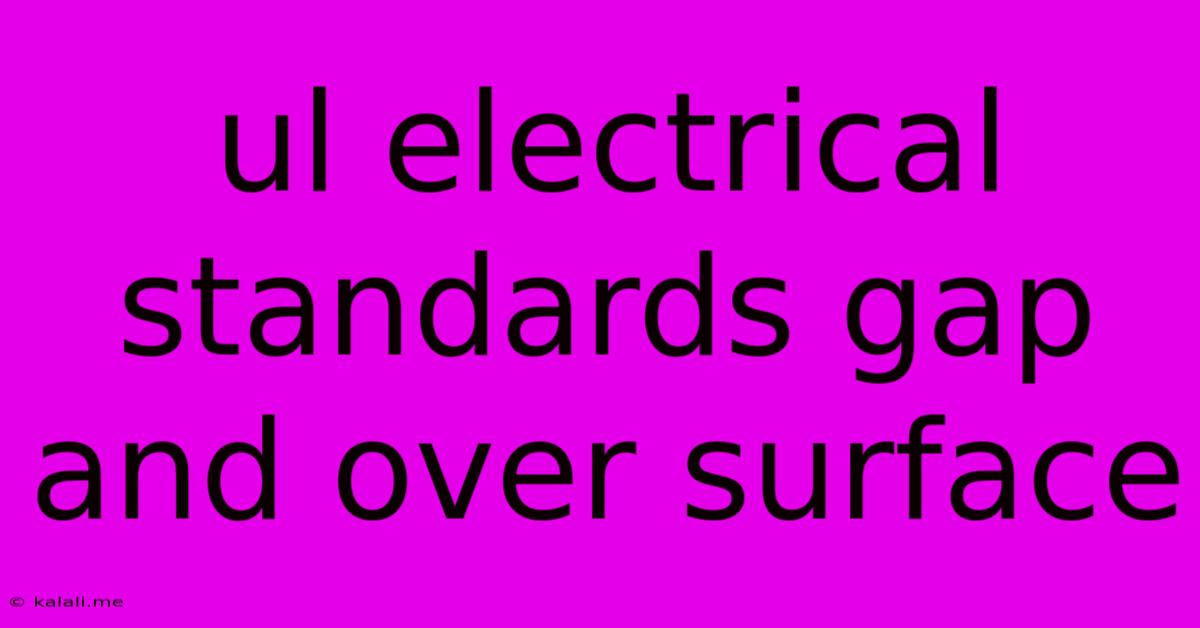Ul Electrical Standards Gap And Over Surface
Kalali
Jun 07, 2025 · 3 min read

Table of Contents
Understanding the UL Electrical Standards Gap and Oversurface Requirements
This article delves into the complexities of Underwriters Laboratories (UL) electrical standards, specifically addressing the often-misunderstood concepts of the "gap" and "oversurface" requirements. These standards are critical for ensuring the safety and reliability of electrical equipment, protecting both users and the broader electrical infrastructure. Understanding these requirements is essential for manufacturers and anyone involved in the design, testing, and certification of electrical products.
What are UL Electrical Standards?
UL standards are a set of safety requirements developed by Underwriters Laboratories, a global safety science company. These standards define the acceptable levels of risk for various electrical products to prevent fire, electric shock, and other hazards. Compliance with UL standards is often a prerequisite for selling electrical products in many markets. They cover a wide range of products, from simple switches and outlets to complex industrial equipment.
The "Gap" Requirement: Maintaining Safe Distances
The "gap" requirement in UL electrical standards refers to the minimum distance required between live parts (carrying electrical current) and other conductive parts, including the enclosure itself. This critical spacing is designed to prevent electrical arcing or short circuits, which could lead to dangerous situations. The required gap varies depending on the voltage and the type of equipment. Several factors influence the gap requirement:
- Voltage: Higher voltages necessitate larger gaps to prevent flashover.
- Insulation: The type and quality of insulation between live parts and other conductive surfaces influence the necessary gap. Better insulation allows for smaller gaps.
- Environmental conditions: Factors such as temperature, humidity, and altitude can impact the dielectric strength of the insulation, thus requiring adjustments to the gap.
- Specific UL Standard: Each UL standard outlines specific gap requirements based on the design and intended use of the equipment.
Failure to maintain the required gap can result in:
- Electrical arcing: Leading to potential fire hazards.
- Short circuits: Causing malfunctions and potential damage to the equipment.
- Electric shock: Posing a significant risk to users.
The "Oversurface" Requirement: Preventing External Contact
The "oversurface" requirement focuses on preventing accidental contact with energized parts. It specifies the minimum distance between the external surface of an enclosure and any live parts within. This requirement is particularly important for equipment that might be accessed by users or located in areas where accidental contact is possible. Like the gap requirement, the oversurface distance depends on various factors:
- Voltage level: Higher voltages demand larger oversurface distances.
- Enclosure design: The type and material of the enclosure significantly influence the oversurface requirements.
- Intended use: Equipment intended for use in hazardous locations requires stricter oversurface distances.
- Applicable UL Standard: The specific standard dictates the exact oversurface dimensions.
Non-compliance with the oversurface requirement exposes users to:
- Electric shock: Direct contact with energized parts can cause severe injury or death.
- Burns: Touching hot surfaces can lead to burns.
Importance of Proper Testing and Certification
To ensure compliance with UL standards, rigorous testing is essential. Independent testing laboratories, accredited by UL, conduct thorough evaluations to verify that products meet the specified gap and oversurface requirements. Successful completion of these tests leads to UL certification, demonstrating compliance and enabling the product to carry the UL mark, a symbol of safety and reliability.
Conclusion:
Understanding the UL electrical standards, particularly the gap and oversurface requirements, is paramount for ensuring the safety and reliability of electrical products. Manufacturers must prioritize adherence to these standards throughout the design, manufacturing, and testing processes. This not only protects users but also maintains confidence in the safety and integrity of the broader electrical system. Failure to comply can result in serious consequences, including product recalls, legal liabilities, and reputational damage. Regular review and adherence to updated UL standards are crucial for maintaining safety and compliance.
Latest Posts
Latest Posts
-
Can You Sue If You Get Swatted
Jun 07, 2025
-
Failed To Start Docker Service Unit Not Found
Jun 07, 2025
-
Im Using Booleen Union Tol And The Object Keeps Disa
Jun 07, 2025
-
Are Song Lyrics Considered Unconventional Literature
Jun 07, 2025
-
Can You Use A Bass Amp For Guitar
Jun 07, 2025
Related Post
Thank you for visiting our website which covers about Ul Electrical Standards Gap And Over Surface . We hope the information provided has been useful to you. Feel free to contact us if you have any questions or need further assistance. See you next time and don't miss to bookmark.